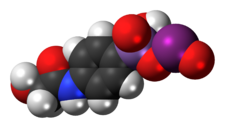Glycobiarsol
Appearance
This article needs more links to other articles to help integrate it into the encyclopedia. (January 2016) |

| |

| |
| Names | |
|---|---|
| IUPAC name
Glycobiarsol
| |
| Systematic IUPAC name
Oxobismuthanyl hydrogen [4-(2-hydroxyacetamido)phenyl]arsonate | |
| Other names
[4-[(2-Hydroxyacetyl)amino]phenyl]-oxobismuthanyl-oxyarsinic acid
| |
| Identifiers | |
3D model (JSmol)
|
|
| ChemSpider | |
| ECHA InfoCard | 100.003.767 |
| EC Number |
|
| KEGG | |
PubChem CID
|
|
| UNII | |
CompTox Dashboard (EPA)
|
|
| |
| |
| Properties | |
| C8H9AsBiNO6 | |
| Molar mass | 499.063 g·mol−1 |
| Pharmacology | |
| P01AR03 (WHO) QP51AD03 (WHO) | |
Except where otherwise noted, data are given for materials in their standard state (at 25 °C [77 °F], 100 kPa).
| |
Glycobiarsol (trade name Milibis) is an antiprotozoal agent that has been used in humans[1] as well as in dogs.[2]
References
- ^ Berberian, D. A. (1954). "The trichomonacidal activity of milibis (glycobiarsol)". New York state journal of medicine. 54 (22): 3102–3105. PMID 13214428.
- ^ Kibble, R. M. (1969). "Glycobiarsol for the control of Trichuris vulpis infection in the dog". Australian Veterinary Journal. 45 (8): 387. PMID 5389346.
